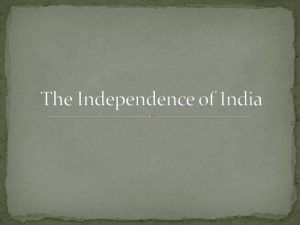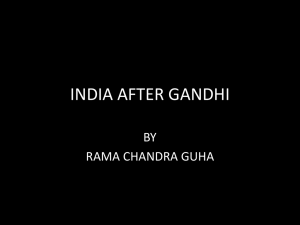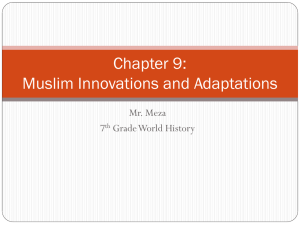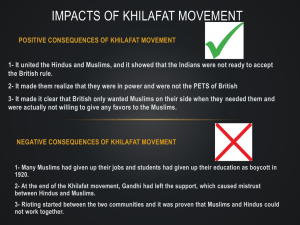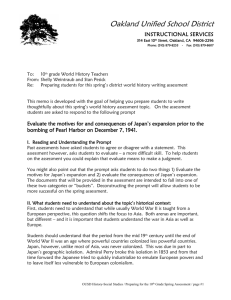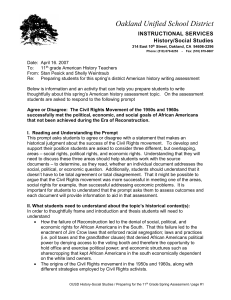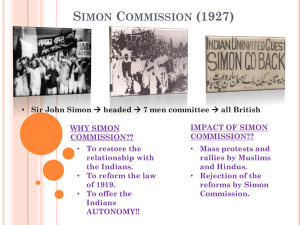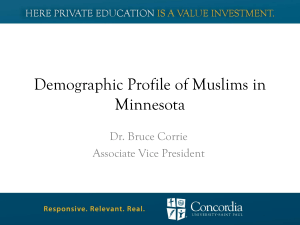OUSD History/Social Studies
advertisement
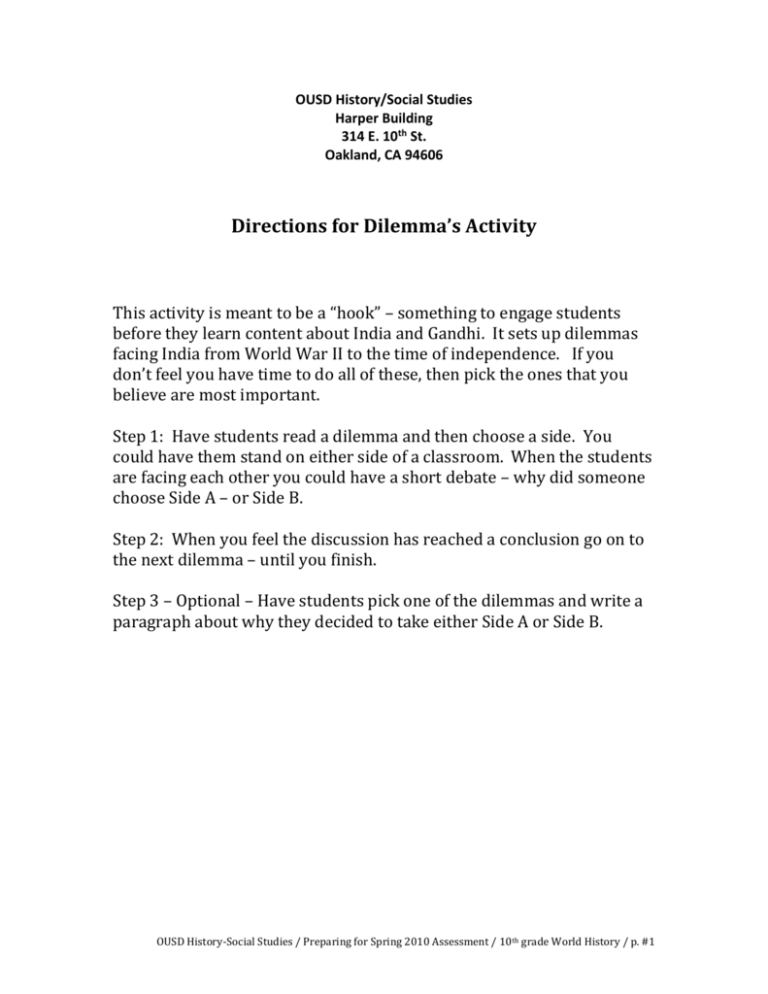
OUSD History/Social Studies Harper Building 314 E. 10th St. Oakland, CA 94606 Directions for Dilemma’s Activity This activity is meant to be a “hook” – something to engage students before they learn content about India and Gandhi. It sets up dilemmas facing India from World War II to the time of independence. If you don’t feel you have time to do all of these, then pick the ones that you believe are most important. Step 1: Have students read a dilemma and then choose a side. You could have them stand on either side of a classroom. When the students are facing each other you could have a short debate – why did someone choose Side A – or Side B. Step 2: When you feel the discussion has reached a conclusion go on to the next dilemma – until you finish. Step 3 – Optional – Have students pick one of the dilemmas and write a paragraph about why they decided to take either Side A or Side B. OUSD History-Social Studies / Preparing for Spring 2010 Assessment / 10 th grade World History / p. #1 Dilemma’s Facing India #1 – Fighting for the British Background – For many years Indians had wanted independence. Britain promised Indians that if they helped the Allies during World War I they would gain home rule or a greater chance to govern themselves. However, after W.W. I, Britain only gave India very limited home rule. By 1940 England was facing another crisis. They were at war with Hitler’s Germany and his ally Japan. Hitler wanted to spread fascism and a belief in white superiority all over the world. Once again, England needed Indian help. Some Indians thought this help should be given, while others disagreed. Side A We must support England, even though we were disappointed with her in the past. For one thing, Hitler is a danger that all of us can understand. If he triumphs he will have even less respect for us then the British. We can see what he is doing to the Jews, gypsies, and other racial minorities. He will probably treat us the same way. Besides, our movement is stronger now and we can force England to give us independence after the war. Finally, we’re still under British rule and if we refuse to serve we will be put in jail. Wouldn’t it be better to be in the army then in jail? Side B We must refuse to fight. First, the British lied to us before, why should we risk our lives for them again? Secondly, the war in Europe does not concern us. We are concerned with the evils of imperialism, which has lasted in India for almost 150 years. The British have made us poor and caused our people to starve. We cannot be distracted by the fact that they are fighting a war with Hitler – no matter how bad he is. Even if it means that we go to jail we should – we must – show the British that we are serious about getting our independence. OUSD History-Social Studies / Preparing for Spring 2010 Assessment / 10 th grade World History / p. #2 #2 – Violence – Non-Violence Background All movements to gain independence from European imperialism throughout Africa and Asia involved struggle. Usually that struggle took many forms including petitions, demonstrations riots and even armed resistance. (For example, in South Africa Mandela led an armed force against apartheid – the system of keeping only white people in power.) In India, however, many believed that the way to force Britain to grant independence was not to allow any violence and to protest nonviolently. While this idea made sense to some, others disagreed. Side A We must do whatever it takes to win independence. The British use arms against us – they have massacred hundreds in cold blood. For example, in Amristar they killed 400 people and wounded over 1,000. These people were there for a peaceful protest. None of them had weapons. To think that we can defeat the British without using weapons is foolish. Look at the Americans – the first nation to become independent of England. They did it by fighting a revolutionary war that took years and many lives – but they won and have become one of the most powerful countries in the world. Side B If we defeat the British by using weapons then we are no better than they are – and we must prove otherwise. By breaking their laws and taking any punishment they give us, we will not only become a stronger people, we will show the rest of the world who is truly civilized. We must be willing to keep fighting for our independence but we must not stoop to their level. If they beat us we must refuse to hit them back. Ultimately they will come to the realization that they want to give us what we need. OUSD History-Social Studies / Preparing for Spring 2010 Assessment / 10 th grade World History / p. #3 #3 – Self Reliance v Industrialization Background: Everyone agreed that too many Indians lived in poverty and didn’t have enough to eat. However, people disagreed about how to solve this problem. Side A The only way India can solve its economic problems is to make it self-reliant. We don’t want to depend on other countries for food and products. Other countries – particularly the British, have exploited us long enough to know that we don’t want to depend on anyone else. Most Indians live in rural communities. Bringing industry to the cities will not help most of the people in the country. Besides, cities are nosy, dirty places where people don’t know or care about each other. If people grow their own food and make their own clothes and build smaller sustainable communities India will go a long way towards achieving real economic independence. Side B The idea of people growing their own food and making their own clothes is an old fashioned idea that the world grew out of over a century ago. We cannot stop progress. We live in an industrialized, global world and to compete and becomes stronger India must face this reality. We need to become industrialized and invest in our cities to make India economically independent. OUSD History-Social Studies / Preparing for Spring 2010 Assessment / 10 th grade World History / p. #4 #4 – Religious vs. Secular state Background – India has always been a country of many religions, but the large majority of Indians are Hindu. The largest minority religion is Islam. (Muslims) When India was about to become its own country the Indian National Congress, a leader in the fight for independence, wanted everyone to live together under one government. The Muslim League, on the other hand, wanted two countries – one for India that would still include many religions and a separate country for Muslims. The debate over this question deeply divided India. Side A- Indian National Congress Hindus, Muslims, Sikhs, Christians, Buddhists; all of us have fought together for an independent India. We don’t want a Hindu India, or a Buddhist India – we want an India where all religions are welcome – we want a government that doesn’t belong to any religion – a secular government. The government shouldn’t favor any one religion. Besides, if we split India apart – one part only for Muslims – it wouldn’t make any sense. Muslims live all over India. Will they have to leave their homes and go to the new Muslim country? And what about the Hindus who live now in what will become a Muslim area – will they have to move? We have lived together for generations – if we turn India into two countries based on religion we are creating suspicion and distrust. This is a terrible idea. Side B - Muslim League The Indian National Congress says they want all of us to be under one government, but that’s because most of them are Hindu and they know the government will favor them. They don’t know what it’s like to be a minority religion. Besides, Muslims and Hindus have never been that close. As our leader Jinnah said, “The Hindus and Muslims belong to two different religious philosophies, social customs, literatures. They neither intermarry nor interdine (eat) together…Muslim India cannot accept any constitution which creates a Hindu majority government…this can only mean Hindu rule.” Mr. Jinnah is correct. It’s not right for us to live under the Hindu’s. We need and deserve our own country. OUSD History-Social Studies / Preparing for Spring 2010 Assessment / 10 th grade World History / p. #5
